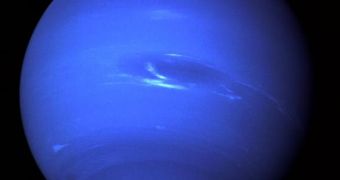Astronomers say that August 20 will mark a very special day in their calendars, as the moment when the gas giant Neptune will complete its first orbit around the Sun, since being discovered back in 1846.
In two days, the planet will be in opposition, which means that it will be on the same straight line as the Earth and the Sun, the experts add.
They reveal that this is generally the time when a celestial body is closest to our planet, and say that the moment is marked by the fact that the target object is revealed exactly opposite to the Sun in the night sky.
This particular case is reason to celebrate, those in-the-know add, because it planet will finally be returning to the spot where it was first discovered in, some 164 years ago, Space reports.
Back in 1846, the gas giant entered opposition on August 20 as well, although it took astronomers at the time until September 23 to identify Neptune as an individual planet.
Though discovered recently, Neptune's existence had been predicted ever since the famed astronomer Sir William Herschel discovered Uranus back in 1781.
At the time, the expert determined that the orbit Uranus took was inconsistent with the one mathematical predictions had laid out for it, which meant that something was influencing it.
That something eventually turned out to be Neptune, whose gravitational pull was destabilizing Uranus' orbit. The planet was discovered by German astronomer Johann Galle, who followed calculations by John Couch Adams and Urbain Le Verrier.
Though the discovery of the planet was disputed between the three, eventually a tie was declared between all of them, and they now share the credit for finding the gas giant.
But neither of them really saw Neptune first, as the honor belongs to Galileo. The astronomer observed the planet of two occasions, December 28, 1612, and January 27, 1613, Space reports.
Still, he had a very poor instrument, and also the misfortune of looking at the gas giant in a moment when it appeared to be stationary, which made him mistake the celestial object for a star.
Neptune remained the farthest planet from the Sun until 1930, when Clyde Tombaugh discovered Pluto, which is now classified as a dwarf planet.

 14 DAY TRIAL //
14 DAY TRIAL //